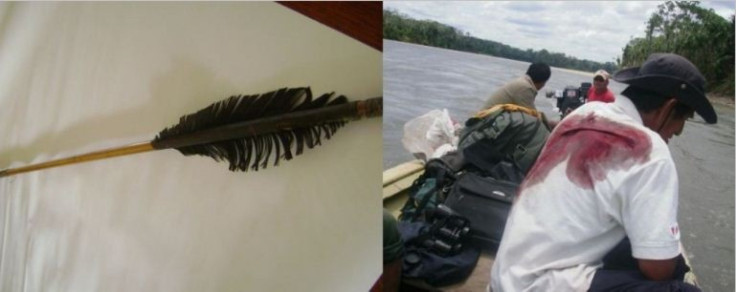Human Safaris Threaten Peru’s ‘Uncontacted’ Mashco-Piro Tribe; Will it Go the Jarawa Way? (Exclusive)

First close-up shot of Mashco-Piro people was released in January 2012. Photo:Survival International/D. Cortijo
Within a month of the release of the first close-up pictures of the “uncontacted” Mashco-Piro tribe of Peru, concerns have surfaced regarding “human safaris” allegedly threatening the tribe.
A few incidents of human safaris reported along the banks of Manu River at the Manu National Park in the Peruvian Amazon rainforest, where the Mashco-Piro people live, have caused worry among tribal rights groups that these safaris will eventually take the form of those happening illegally in the Jarawa reserve of India’s Andaman Islands, which pose a great risk to the indigenous Jarawa tribe.
What happened with the Jarawa?
A video showing two naked Jarawa women dancing for tourists on the Andaman Trunk road that cuts right through the Jarawa reserve, the land they inhabit, caused much uproar last month. In fact, illegal tourism in the Jarawa reserve was first exposed in 2010.
Despite a ruling by the Indian Supreme Court in 2002 which ordered the highway to be shut down, the Andaman Trunk road is still a mute witness to illegal human safaris that put the Jarawas at risk of acquiring infection from contact with the outside world through food items and clothes offered by the tourists.
The video, an example of the height of the tribe’s exploitation, called for prompt action from the government.
Peru’s Mashco-Piro Seeing the Jarawa’s Fate
Peru’s Mashco-Piro tribe seems to be falling in a similar trap as the Jarawas. Some tourists boating on Manu River were seen dropping off a piece of cloth close to the land of the Mashco-Piro on the riverbank.
In yet another incident, two young filmmakers, who visited the Manu National Park last year, were taken along the stretch of the Manu River by a tour guide who encouraged them to stop and take photos of the tribe, according to Survival International, a leading organization working for tribal rights worldwide.
G. Galli, an Italian tourist, was on a birdwatching trip when she saw the Mashco-Piro. Photo Credit: © G. Galli/uncontactedtribes.org
Human Safaris: Mascho-Piro vs. Jarawa
Despite similar attempts by tourists to establish contact with the two tribes in Peru and the Andaman Islands, Survival’s Chloe Corbin feels that there are still many differences between the kind of human safaris being carried out at the Jarawa reserve in the Andaman and the Manu River in Peru.
“The Andaman’s tour operators are acting illegally on a road that was ordered shut by India's Supreme Court, whereas in Peru, the river running along the Manu National Park is not closed to tourists/the public. In fact, the area is very popular with bird enthusiasts who take trips around the Park to spot unusual wildlife,” Corbin told IBTimes.
Corbin said that human safari is at a very early stage in the Manu National Park, a well-known tourist destination in southeastern Peru, unlike in the Andaman where it’s “well-established.” Also there is no evidence of direct contact with the Peruvian tribe.
“As far as we know, the Mashco-Piro has not been directly contacted by tourists, nor has been ordered to dance/entertain onlookers, as is the case in the Andaman,” she said.
Up to now, the Mashco-Piro people have remained “uncontacted,” which puts them at a higher risk from outsiders. The Jarawa tribe, on the contrary, has developed at least some immunity due to intermittent contact with the outside world since 1998, when some of the Jarawas started appearing on the Andaman Trunk road.
“If contact was made, it's quite likely a common cold could kill members of the tribe, whereas the Jarawa have now endured over a decade of contact, making them more immune. Mashco-Piro people have not, and this makes the health risks even more pronounced,” she added.
Apart from the differing intensity of menace from human safaris, Corbin said the Mashco-Piro tribe is threatened by logging and oil and gas projects as well, unlike the Jarawa for whom the main risk is only from poachers, tourists and tour operators using the illegal Andaman Trunk Road.
“The Mashco-Piro people are being driven out of their forests to the water's edge by illegal logging in the Amazon, and low flying helicopters from oil and gas projects.”
Violent Attack on Outsiders
Sightings of the Mashco-Piro tribe have been reported by the park ranger staff, birdwatchers and tourists in the past one year. These indigenous people were often spotted running after tourist boats along the Manu River and even firing arrows at tourists in some cases, according to National Service for Protected Natural Areas (SERNANP), the state agency responsible for regulating the Protected Natural Areas in Peru.
Though the agency remains clueless about the reason why these people often come along the riverbank, officials took an attack on a park ranger by a blunt arrow in October last year as a warning signal from the tribes asking outsiders to keep away from their region.
The blunt arrow (L) which was shot at Jesus Keme (R) while patrolling on Oct. 14, 2011, led to bleeding. Image Credit: SERNANP
Peru has the third largest number of uncontacted tribal groups in the world after Brazil and New Guinea. Peruvian authorities consider that “uncontacted tribes should under no circumstances be contacted,” and for the Mashco-Piro tribe, which remains “uncontacted” till date, officials believe there is still time to not let it go the Jarawa way.
“There is still time to act – to make people aware and stop unscrupulous tour operators before contact is forced (like in the case of the Jarawa) and their land rights exploited,” Corbin concluded.
Read Related Stories: Andaman’s Jarawa Tribes Treated as ‘Circus Ponies’ in Police Presence; Threat From Illegal Tourism Palpable Andaman Administration Questioned over Alleged Exploitation of Jarawa Tribals Jarawa People in ‘Beastly Conditions’ Survived Tsunami 2004; Will They Succumb to Govt.’s Call for ‘Mainstreaming’?
© Copyright IBTimes 2024. All rights reserved.











